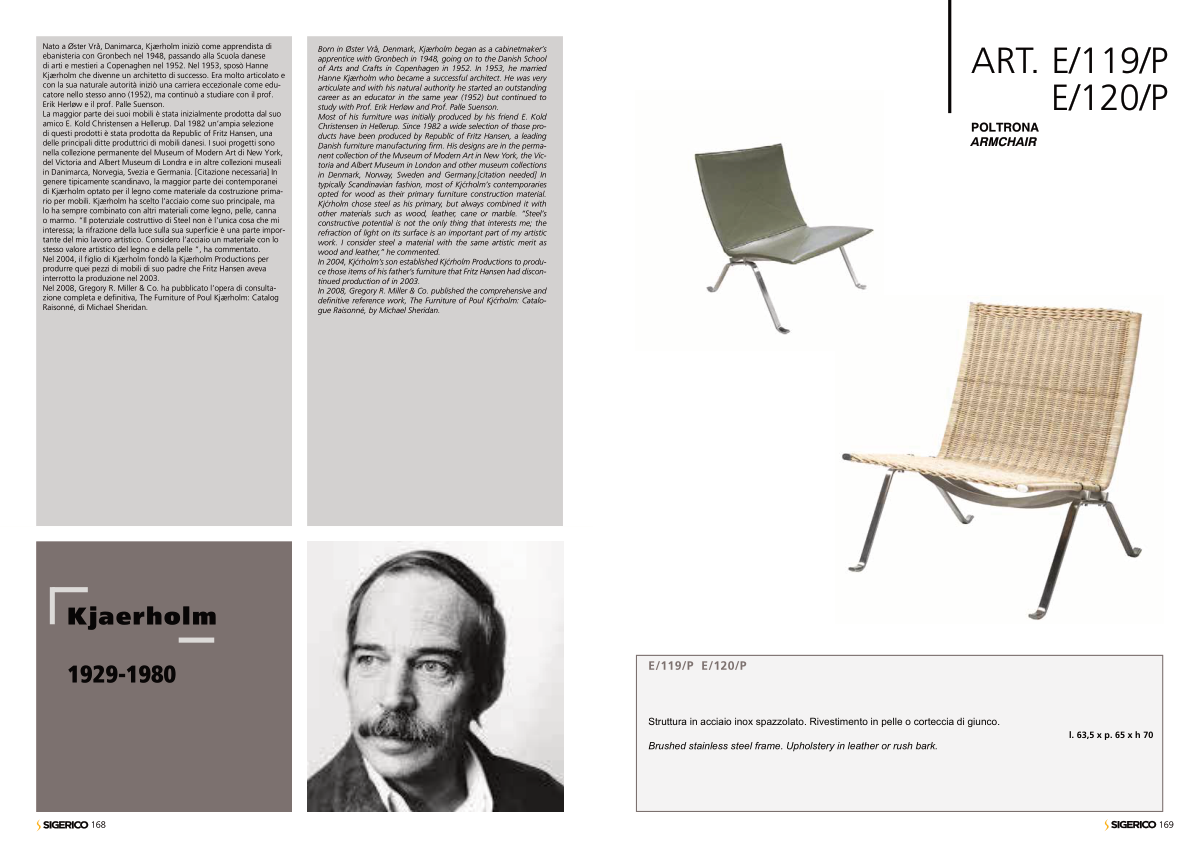Kjaerholm
1929-1980
Nato a Øster Vrå, Danimarca, Kjærholm iniziò come apprendista di
ebanisteria con Gronbech nel 1948, passando alla Scuola danese
di arti e mestieri a Copenaghen nel 1952. Nel 1953, sposò Hanne
Kjærholm che divenne un architetto di successo. Era molto articolato e
con la sua naturale autorità iniziò una carriera eccezionale come edu-
catore nello stesso anno (1952), ma continuò a studiare con il prof.
Erik Herløw e il prof. Palle Suenson.
La maggior parte dei suoi mobili è stata inizialmente prodotta dal suo
amico E. Kold Christensen a Hellerup. Dal 1982 un’ampia selezione
di questi prodotti è stata prodotta da Republic of Fritz Hansen, una
delle principali ditte produttrici di mobili danesi. I suoi progetti sono
nella collezione permanente del Museum of Modern Art di New York,
del Victoria and Albert Museum di Londra e in altre collezioni museali
in Danimarca, Norvegia, Svezia e Germania. [Citazione necessaria] In
genere tipicamente scandinavo, la maggior parte dei contemporanei
di Kjærholm optato per il legno come materiale da costruzione prima-
rio per mobili. Kjærholm ha scelto l’acciaio come suo principale, ma
lo ha sempre combinato con altri materiali come legno, pelle, canna
o marmo. “Il potenziale costruttivo di Steel non è l’unica cosa che mi
interessa; la rifrazione della luce sulla sua superficie è una parte impor-
tante del mio lavoro artistico. Considero l’acciaio un materiale con lo
stesso valore artistico del legno e della pelle “, ha commentato.
Nel 2004, il figlio di Kjærholm fondò la Kjærholm Productions per
produrre quei pezzi di mobili di suo padre che Fritz Hansen aveva
interrotto la produzione nel 2003.
Nel 2008, Gregory R. Miller & Co. ha pubblicato l’opera di consulta-
zione completa e definitiva, The Furniture of Poul Kjærholm: Catalog
Raisonné, di Michael Sheridan.
Born in Øster Vrå, Denmark, Kjærholm began as a cabinetmaker’s
apprentice with Gronbech in 1948, going on to the Danish School
of Arts and Crafts in Copenhagen in 1952. In 1953, he married
Hanne Kjærholm who became a successful architect. He was very
articulate and with his natural authority he started an outstanding
career as an educator in the same year (1952) but continued to
study with Prof. Erik Herløw and Prof. Palle Suenson.
Most of his furniture was initially produced by his friend E. Kold
Christensen in Hellerup. Since 1982 a wide selection of those pro-
ducts have been produced by Republic of Fritz Hansen, a leading
Danish furniture manufacturing firm. His designs are in the perma-
nent collection of the Museum of Modern Art in New York, the Vic-
toria and Albert Museum in London and other museum collections
in Denmark, Norway, Sweden and Germany.[citation needed] In
typically Scandinavian fashion, most of Kjærholm’s contemporaries
opted for wood as their primary furniture construction material.
Kjærholm chose steel as his primary, but always combined it with
other materials such as wood, leather, cane or marble. “Steel’s
constructive potential is not the only thing that interests me; the
refraction of light on its surface is an important part of my artistic
work. I consider steel a material with the same artistic merit as
wood and leather,” he commented.
In 2004, Kjærholm’s son established Kjærholm Productions to produ-
ce those items of his father’s furniture that Fritz Hansen had discon-
tinued production of in 2003.
In 2008, Gregory R. Miller & Co. published the comprehensive and
definitive reference work, The Furniture of Poul Kjærholm: Catalo-
gue Raisonné, by Michael Sheridan.
ART. E/119/P
E/120/P
POLTRONA
ARMCHAIR
Struttura in acciaio inox spazzolato. Rivestimento in pelle o corteccia di giunco.
Brushed stainless steel frame. Upholstery in leather or rush bark.
l. 63,5 x p. 65 x h 70
169
168
E/119/P E/120/P


